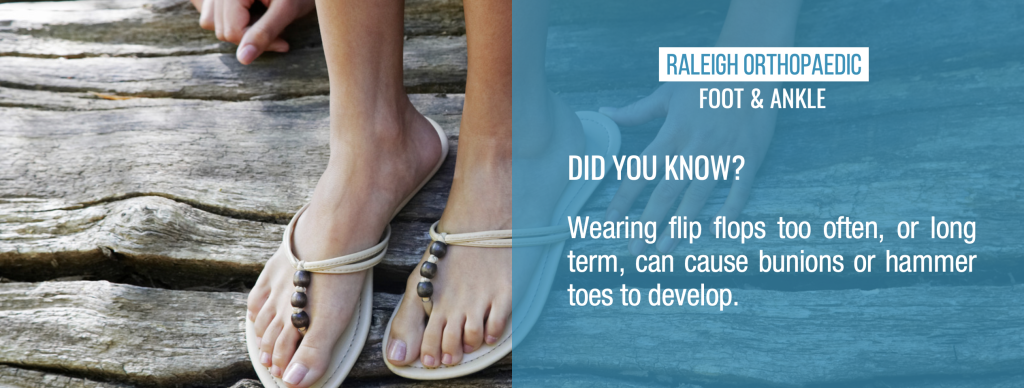According to the Consumer Product Safety Commission, nearly 25,000 people visit the emergency room every year for flip-flop related injuries. Flip-flops have a bad reputation because of their lack of support, protection, cushioning and lack of functionality. The positive about flip-flops is convenience; they are easy to wear.
Does wearing flip-flops damage your feet?
There are several foot and ankle conditions that can develop from wearing flip-flops for casual, everyday use. While wearing flip-flops, most people tend to increase toe-curling because it helps hold the shoe on. Short term, this may cause tendinitis. Wearing flip flops too often, or long term, can cause bunions or hammer toes to develop. Hammer toes occur when the joints contract, causing your toe to bend abnormally.
Flip-flops also cause a shorter stride in walking, leading to possible tightness of the Achilles, which may result in Achilles tendinitis. Additionally, the absence of arch support could lead to inflammation and plantar fasciitis. Without proper shock absorption in flip flops, stress fractures can occur in the bones of the feet. Wearing flip flops while standing or walking for long periods of time can cause minute cracks in your foot bones.

Foot Structure
Flip-flops are fine for some people and not for others. Eighty-five percent of people in the United States have reasonably ‘normal’ feet; therefore, periodic flip-flop wearing is tolerable. According to the American Orthopaedic Foot and Ankle Society, a normal foot is defined as not having a significant high arch or flatfoot deformity with good motion of the ankle and hindfoot joints. If you have a normal foot and your activity level is low (such as walking or standing on a level surface for a few hours at a time), then flip-flop wearing is reasonable and similar to walking barefoot.
The problems come when individuals have deformities, poor balance or numb feet. For these individuals, flip-flops do not provide adequate support, can be dangerously unstable and do not adequately protect the feet.
Flip-flops can also be harmful for those with flat feet because the shoes do not provide much support. A study conducted by Auburn University found that flip-flops can cause ankle, leg and feet pain for those with flat feet or other foot problems. Researchers found that flip-flop wearers take shorter steps and their heels hit the ground with less vertical force than when wearing athletic shoes.
Flip-flops should also not be worn during sporting events, especially any type of running, or jumping due to their lack of support and protection. Try to avoid uneven ground due to the instability of the flip-flop on the foot. Do not wear flip-flops when driving, as they may come off and get caught in the brake or accelerator pedals. Do not wear flip-flops when doing yard work due to the risk of injuries from rocks or debris, and to prevent animal bites. Do not wear them when riding a motorcycle, around machinery or power tools to prevent injury.
Flip-flops are great at a pool or beach, as they protect from hot concrete and sand, but don’t forget to protect your feet with sunscreen. They are good for short distances, such as going to the grocery store for a few items. Flip-flops are best on flat surfaces. Flip-flops are also great for public showers to avoid warts or fungus. In conclusion, for a normal foot, flip-flops are a reasonable shoe wear option in moderation.
Are there safe alternatives?
Not all flip-flops are created equal. Flip-flops should be stiffer and only bend at the forefoot where the toes join the foot. Bending in other locations is not ideal but can be tolerated for short periods of time. Some arch support in the flip-flop is better than none. More cushioning is also better than less. Flip-flops with more than one strap to hold the shoe on are more stable to prevent blistering. Accurate sizing is critical; there should not be any overhang while wearing flip-flops.

LEARN MORE ABOUT FOOT and ANKLE TREATMENT AT RALEIGH ORTHOPAEDIC
Schedule an appointment
Your well-being is important to us. Raleigh Orthopaedic is Wake County’s oldest and most experienced orthopedic practice, serving the Triangle and surrounding regions of central North Carolina since 1919. Click the button below or call us to schedule an appointment with one of our orthopedic specialists. If your injury or condition is recent, you can walk right into one of our Raleigh Orthopaedic Urgent Care locations for immediate care. For rehabilitation and physical therapy, no referral is needed to see one of our physical therapists.
